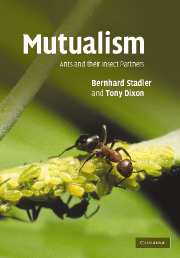5 - A special case: aphids and ants
Published online by Cambridge University Press: 13 August 2009
Summary
Features associated with ant attendance
Phloem sap is a poor diet because of its low nitrogen concentration, unbalanced composition, and temporal variability in quality (e.g. nitrogen or secondary metabolite content). Nitrogen is mostly present in low concentrations usually ranging between 50 and 300 mM (0.8–4.5% w/v) (Mittler 1958, Ashford et al. 2000, Sandström and Moran 2001). Intracellular aphid symbionts (Buchneria) provide their host with amino acids, which are otherwise in short supply in the phloem sap, and the symbiosis between aphids and bacteria is considered as essential for utilizing phloem sap (Douglas 1998). Adaptations to utilize this resource might offer opportunities and cause problems with respect to mutualistic interactions with ants. For example, different ant species and different groups within an ant colony have different nutritional needs at different times of the year. Workers rely on carbohydrates for their energy needs during foraging, whereas larvae require mainly nitrogenous food for growth. Like phloem sap, honeydew is a nitrogen-poor diet and, as a consequence, ants must be able to adapt to this resource. For example, some ant species harbour micro-organisms in their digestive tract, probably to supplement the liquid diet with essential amino acids and other nutrients (Roche and Wheeler 1997).
A large number of adaptations have been shown (some of which were described in previous chapters) to influence to some extent the strength of the interactions between ants and aphids, which range from positive to negative.
- Type
- Chapter
- Information
- MutualismAnts and their Insect Partners, pp. 89 - 106Publisher: Cambridge University PressPrint publication year: 2008

